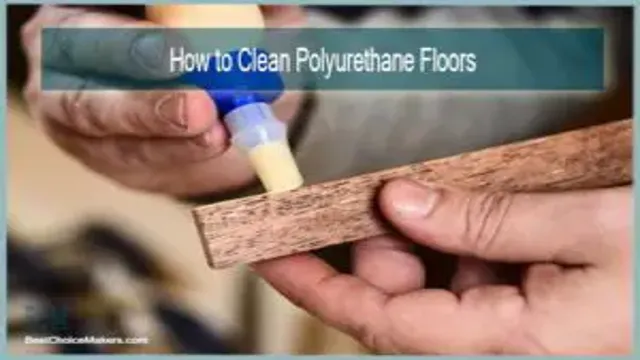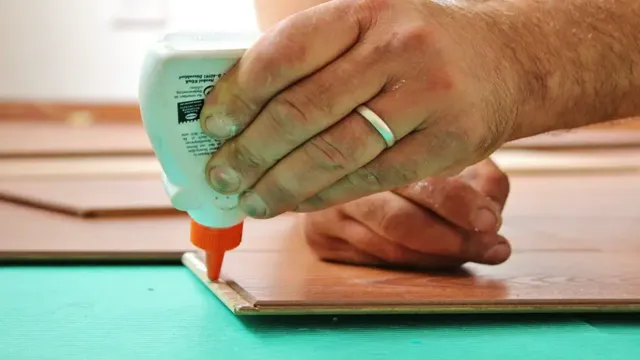Wood glue is an essential tool for any woodworking project, with its ability to bond pieces of wood together, creating a strong and durable hold. But, before reaching for the wood glue, it’s important to know what it will and will not stick to. While wood glue is effective at bonding wood, it may not work as well on other materials, such as metal, plastic, or glass.
Understanding the limitations of wood glue is crucial, especially if you’re working on a project that requires bonding different materials together. For example, using wood glue to join metal pieces may not provide the same level of strength and durability as a specific industrial glue designed for metal bonding. When it comes to wood, however, the possibilities are endless.
Wood glue is perfect for joining various types of wood, including soft, hard, and plywood. It’s ideal for fixing broken furniture, creating wooden sculptures, or constructing a wooden deck. Overall, knowing what wood glue is suited for is important in making sure your project is successful and long-lasting.
So before you reach for the wood glue, take a moment to evaluate the materials you intend to bond and ensure that wood glue is the best option for the job at hand.
Introduction
If you are someone who frequently works with wood, then you understand how important it is to use the right kind of glue for any project. Wood glue is incredibly strong and durable, but there are certain materials that it won’t stick to. For example, wood glue will not adhere properly to surfaces that are coated in oil or wax.
If you try to glue two pieces of wood together and there is oil or wax present, then the bond will not be strong enough to hold. Additionally, wood glue will not stick well to surfaces that are not completely clean or free of debris. It is important to prepare any surface thoroughly before applying wood glue to ensure that it can properly bond with the wood.
Explanation of Wood Glue
Wood glue is an essential tool for every woodworker, furniture maker, and DIY enthusiast. It’s a type of adhesive specifically designed for bonding wood, and it comes in various types and formulations. The most common types of wood glue are PVA glue, polyurethane glue, hide glue, epoxy resin, and cyanoacrylate glue.
Each type of wood glue has its own unique properties and set of benefits, which makes it suitable for specific woodworking applications. For instance, PVA glue is best used for indoor woodworking projects since it’s water-resistant and easy to clean up, while polyurethane glue is ideal for outdoor use because of its superior waterproofing properties. Wood glue works by penetrating the wood’s pores and creating a strong chemical bond between the adhesive and wood fibers.
It’s important to note that wood glue works best when the wood surfaces to be bonded are clean, dry, and free from dust or debris. The wood surfaces should also be properly aligned and clamped together to ensure a tight and secure bond. In conclusion, understanding the various types of wood glue available in the market and their respective properties is critical to choosing the right adhesive for your specific woodworking project.
Whether you’re a seasoned professional or DIY enthusiast, using the appropriate wood glue will ensure your projects are structurally sound and long-lasting. So, the next time you’re working on a woodworking project, remember to choose the right type of wood glue that suits your needs.

Importance of Knowing What Wood Glue Will Not Stick to
Knowing what wood glue will not stick to is crucial when it comes to creating quality woodworking projects that last. There are many types of wood glue available, and each one has its strengths and weaknesses, so understanding their limitations can save you time, effort, and money in the long run. Some types of glue, for instance, may not work well on oily or wet wood, while others may not bond adequately to certain types of plastic or metal fasteners.
Therefore, it is essential to choose the right wood glue for your specific needs to ensure optimal results. By doing so, you can avoid costly mistakes and achieve excellent bonding with your woodworking projects.
What Wood Glue Will Not Stick to
When it comes to woodworking, choosing the right glue can make all the difference. However, there are certain types of materials that wood glue will not adhere to. One such material is plastic, as wood glue is designed to bond porous surfaces together and plastic doesn’t provide the necessary surface area to create a strong bond.
Other non-porous materials such as glass, metal, and smooth ceramics also pose a challenge for wood glue. Additionally, surfaces that are oily or greasy can make it difficult for the glue to properly adhere. It’s important to note that some types of wood can also be difficult to bond with wood glue, depending on their natural oils and tannins.
When working with these types of wood, it’s best to use a specialized adhesive designed specifically for that type of wood. So if you’re working on a woodworking project, be sure to consider the materials you’ll be bonding together to ensure the best possible results.
Plastic and Metal Surfaces
When it comes to woodworking, choosing the right glue is essential for a successful project. While wood glue is an excellent adhesive for wooden surfaces, it can have difficulty sticking to plastic and metal surfaces. These materials have a nonporous surface, which means that wood glue cannot penetrate the surface to bond the two materials together.
Additionally, plastic and metal surfaces have a smooth and shiny finish, which makes it difficult for the glue to adhere. Therefore, it’s essential to choose a glue that is designed to bond these materials. For plastic surfaces, you can use a cyanoacrylate glue, also known as super glue, or a two-part epoxy adhesive.
For metal surfaces, you can use a two-part epoxy, polyurethane adhesive, or cyanoacrylate glue. Overall, it’s crucial to choose the right glue for the right surfaces to ensure a strong and long-lasting bond.
Wet or Greasy Surfaces
When it comes to wet or greasy surfaces, finding the right wood glue can be a challenge. Most wood glues are designed to work on dry and clean surfaces, which means they may not be effective in these situations. The best option for these surfaces is a polyurethane glue.
This type of glue is designed to be waterproof and can adhere to a variety of surfaces, including wet and greasy ones. However, it’s important to keep in mind that polyurethane glue can be messy and difficult to clean up, so it’s important to use it carefully. Additionally, it may take longer to dry than other types of wood glue, so make sure to follow the instructions carefully and allow plenty of time for it to dry.
By choosing the right wood glue and taking the proper precautions, you can successfully bond wood even in challenging environments.
Non-Porous Surfaces
When it comes to woodworking, gluing pieces of wood together is a crucial step in the process. However, not all wood glues are created equal, and some may not stick to certain non-porous surfaces. For instance, polyurethane glue may not adhere well to surfaces such as glass, metal, or plastic, as these materials are too smooth and non-porous.
Similarly, cyanoacrylate glue, also known as superglue, may not work well on non-porous surfaces, as it requires a certain amount of moisture to activate and form a strong bond. In these cases, epoxy glue may be a better option, as it can bond to a wider range of materials, including non-porous surfaces. But as always, it’s important to check the manufacturer’s instructions and use the right type of glue for the specific materials you’ll be working with to ensure a strong and durable bond.
Sandpapered Surfaces
When it comes to woodworking, wood glue is an essential tool for any DIY project. However, there are certain surfaces that it may not stick to, such as sandpapered surfaces. The reason for this is that sandpapering the wood creates a smooth, even surface that does not allow the glue to penetrate and bond the wood fibers together.
Additionally, if the surface is too smooth, the glue can have trouble adhering to it, as there is not enough surface area for a strong bond to form. In these cases, it may be necessary to rough up the surface of the wood before applying the glue to ensure a strong bond. Another factor that can impact the bond of wood glue is moisture.
If the wood is too wet or too dry, the glue may not adhere properly. Therefore, it’s important to ensure that the wood is properly seasoned and to follow the manufacturer’s instructions when using wood glue for any project.
Conclusion
In conclusion, when it comes to the question of what wood glue does not stick to, the answer lies not in the material, but in the intention. Just like how love cannot stick to material possessions, wood glue cannot stick to surfaces that lack the necessary qualities to properly bond. So, make sure to choose the right surface for your woodworking project, and let your love stick to the important things in life.
“
Importance of Choosing the Right Glue for the Job
When it comes to woodworking projects, choosing the right type of glue is critical. However, not all wood glue will adhere to every surface, and it is important to know what types of wood glue will not stick to. For example, superglue or cyanoacrylate glue is not suitable for hardwoods or oily woods like cedar or teak.
The glue will not bond these surfaces effectively, and the result will be weak, brittle joints that will eventually fail. PVA glue is another popular option, but it may not be suitable for outdoor projects as it weakens when exposed to moisture. When choosing wood glue, it is essential to consider the type of wood being used, the intended environment, and the project’s use to ensure the right adhesive is chosen.
By selecting the right glue for the job, woodworkers can ensure their results are strong, durable, and long-lasting.
FAQs
What types of surfaces will wood glue not adhere to?
Wood glue may not stick well to certain surfaces, such as plastic, metal, or glass.
Can you use wood glue on damp wood?
It is not recommended to use wood glue on damp wood, as the moisture can affect the strength of the bond.
How long does it take for wood glue to dry?
The drying time for wood glue can vary based on factors such as temperature and humidity, but it usually takes anywhere from 30 minutes to several hours to fully dry.
Is wood glue waterproof?
Some types of wood glue are waterproof, while others are not. It is important to check the label or product specifications to determine if the glue is suitable for outdoor or wet conditions.
Can you stain over wood glue?
It is possible to stain over wood glue, but it is important to make sure the glue is fully dry and sanded smooth before applying any stain or finish.
Can wood glue be used for furniture repairs?
Yes, wood glue is a common choice for repairing furniture joints or attaching new pieces to existing furniture.
How do you clean up excess wood glue?
Excess wood glue can be wiped away with a damp cloth or scraped off with a sharp tool before it dries. Once it is dry, it can be sanded or chiseled off as needed.






